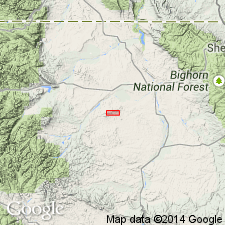
- Usage in publication:
-
- Fenton Pass Formation*
- Modifications:
-
- Named
- Dominant lithology:
-
- Conglomerate
- Sandstone
- AAPG geologic province:
-
- Bighorn basin
Summary:
Named for exposures on both sides of Fenton Pass, 35 mi northwest of Worland, WY. Type section is in N1/2 SE1/4 sec 24, T50N, R98W, Park Co, in the Bighorn basin. Divisible into a lower conglomerate member, a conglomerate of well-rounded pebbles, cobbles, and boulders, made up mostly of andesite, quartzite, chalcedony, and silicified coniferous wood with calcareous cement, about 36 ft thick, and an upper sandstone member, grayish brown, fine to very fine grained, silty and clayey, 10 ft thick. The sandstone is composed of angular grains of andesitic rocks. Rests unconformably on Tatman Formation. Contains late Cenozoic pollen and redeposited pollen, probably from the underlying Tatman Formation. Lower member is a channel deposit. The upper member is a flood-plain deposit. Assigned a Pleistocene? age. Areal extent shows distribution of sandstone and conglomerate members in 5 areas in Park and Bighorn Cos. Tables list the pollen found in and redeposited in the formation. Measured section. Replaces name Tatman Mountain Gravels.
Source: GNU records (USGS DDS-6; Denver GNULEX).
For more information, please contact Nancy Stamm, Geologic Names Committee Secretary.
Asterisk (*) indicates published by U.S. Geological Survey authors.
"No current usage" (†) implies that a name has been abandoned or has fallen into disuse. Former usage and, if known, replacement name given in parentheses ( ).
Slash (/) indicates name conflicts with nomenclatural guidelines (CSN, 1933; ACSN, 1961, 1970; NACSN, 1983, 2005, 2021). May be explained within brackets ([ ]).

